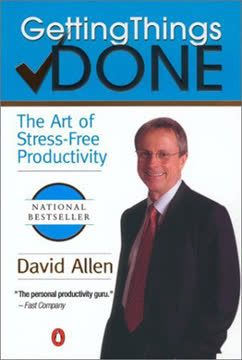Key Takeaways
1. Establish clear limits and focus on one thing at a time
A clear vision is as much about what you are not going to do as it is about what you are going to do.
Focused productivity. Establishing clear limits and focusing on one thing at a time are fundamental principles of effective time management. By setting boundaries on your work and commitments, you create a framework for increased productivity and reduced stress. This approach helps prevent overwhelm and allows for deeper engagement with tasks.
Benefits of limitation:
- Improved concentration and quality of work
- Reduced mental clutter and decision fatigue
- Increased likelihood of task completion
- Better work-life balance
Implementing this principle requires conscious effort to say "no" to non-essential activities and distractions. Regularly review your commitments and eliminate those that don't align with your primary goals or values. Remember, every "yes" to one thing is a "no" to something else.
2. Create a buffer between stimulus and response
To complain about a shortage of time is like a fish in the sea complaining that it has a shortage of water.
Reactive vs. proactive. Creating a buffer between stimulus and response is crucial for maintaining control over your time and actions. This principle involves pausing before reacting to incoming tasks, requests, or information, allowing you to make more thoughtful and strategic decisions.
Implementing buffers:
- Batch processing emails and messages at set times
- Using a "holding area" for new tasks before adding them to your main to-do list
- Practicing the "24-hour rule" before committing to new requests
By creating these buffers, you reduce the likelihood of being constantly interrupted and pulled in different directions. This approach helps maintain focus on your priorities and prevents the day from becoming a series of reactive responses to external stimuli.
3. Implement the "Do It Tomorrow" system
Nothing is so urgent that it can't be put off till tomorrow.
Structured delay. The "Do It Tomorrow" system is a powerful approach to managing daily tasks and incoming work. This method involves collecting all incoming tasks during one day and processing them the following day, creating a natural buffer and allowing for more structured and efficient work.
Key components of the system:
- Collect all incoming work (emails, voicemails, tasks) during the day
- Process yesterday's work in batches the following day
- Use a "will-do" list instead of a traditional to-do list
- Maintain a separate list for genuinely urgent same-day tasks
This system helps reduce the feeling of being overwhelmed by incoming work and allows for better planning and prioritization. It also helps break the cycle of constant interruptions and reactionary work habits, leading to increased productivity and reduced stress.
4. Use closed lists to increase efficiency
A closed list is a way of applying limits to our work in order to increase our efficiency.
Finite focus. Closed lists are a powerful tool for increasing efficiency and maintaining focus. Unlike open-ended to-do lists that can grow endlessly, closed lists have a defined set of tasks that cannot be added to once created. This limitation encourages completion and reduces the tendency to constantly shift priorities.
Benefits of closed lists:
- Clearer sense of progress and accomplishment
- Reduced decision fatigue
- Increased likelihood of task completion
- Better time estimation and planning
To implement closed lists, create a daily "will-do" list with a realistic number of tasks that can be completed in one day. Once the list is created, resist the urge to add new items until the current list is finished. This approach helps maintain focus and prevents the constant shuffling of priorities that often occurs with traditional to-do lists.
5. Distinguish between real work and busy work
Busy work often looks more like work than real work does.
Meaningful productivity. Distinguishing between real work and busy work is crucial for maximizing productivity and achieving important goals. Real work advances your business or career, utilizes your skills fully, and often takes you out of your comfort zone. Busy work, on the other hand, often feels productive but doesn't contribute significantly to your primary objectives.
Characteristics of real work vs. busy work:
Real work:
- Directly impacts bottom line or key objectives
- Requires your unique skills and expertise
- Often challenging or outside comfort zone
Busy work:
- Feels productive but doesn't advance key goals
- Could be delegated or eliminated
- Often used to avoid more challenging tasks
Regularly assess your activities to ensure you're focusing on real work. Be honest about which tasks are truly essential and which are merely keeping you busy. Eliminate or delegate busy work to free up time for more impactful activities.
6. Overcome procrastination through structured approaches
Lying is an attribute of the rational mind.
Strategic self-deception. Overcoming procrastination requires understanding the psychological mechanisms behind it and implementing structured approaches to combat it. One effective technique is to "fool" the reactive mind by pretending not to do the resisted task while taking small steps towards it.
Techniques to overcome procrastination:
- Use the phrase "I'm not really going to [task] now, but I'll just [small step]"
- Work in timed bursts (e.g., 25 minutes of focused work followed by a 5-minute break)
- Break large tasks into smaller, less intimidating steps
- Use positive self-talk and reframing techniques
Remember that procrastination is often rooted in feelings of being overwhelmed or fears of failure. By using these structured approaches, you can bypass the emotional resistance and make steady progress on important tasks.
7. Prioritize projects by reverse order of urgency
I don't believe that anyone consistently prioritises by importance because it's virtually impossible to do so.
Proactive planning. Prioritizing projects by reverse order of urgency is a counterintuitive but effective approach to managing multiple projects. This method involves tackling less urgent tasks first, which prevents them from becoming urgent later and reduces overall stress and last-minute rushes.
Benefits of reverse urgency prioritization:
- Reduces artificial emergencies
- Improves work quality by allowing more time for important tasks
- Decreases stress by spreading work more evenly
- Increases overall productivity and efficiency
To implement this approach, regularly review your projects and identify those with the most distant deadlines. Allocate time to work on these projects consistently, even if they don't feel urgent. This proactive approach prevents the buildup of last-minute crises and allows for more thoughtful, high-quality work across all projects.
8. Delegate effectively to maximize productivity
You will never get anyone to attach a higher priority to your work than they perceive you are giving to it yourself.
Empowering others. Effective delegation is crucial for maximizing productivity and achieving larger goals. It involves not just assigning tasks, but also empowering others to take ownership and develop their skills. Proper delegation frees up your time for high-level tasks while developing your team's capabilities.
Keys to effective delegation:
- Delegate tasks as soon as possible, not at the last minute
- Provide clear instructions and expectations
- Set realistic deadlines with built-in buffers
- Follow up regularly without micromanaging
- Offer support and resources as needed
Remember that delegation is a skill that improves with practice. Resist the urge to do everything yourself, even if it seems faster in the short term. Effective delegation leads to long-term productivity gains and a more capable team.
Last updated:
FAQ
What's "Do It Tomorrow and Other Secrets of Time Management" about?
- Overview of the book: "Do It Tomorrow and Other Secrets of Time Management" by Mark Forster is a guide to improving personal productivity by rethinking traditional time management techniques.
- Core concept: The book introduces the "mañana principle," which suggests handling today's tasks tomorrow to create a buffer and reduce randomness.
- Focus on closed lists: Forster emphasizes using closed lists to manage tasks, which helps in completing daily work efficiently without being overwhelmed by new tasks.
- Practical advice: The book provides practical methods for dealing with backlogs, setting priorities, and maintaining focus on real work versus busy work.
Why should I read "Do It Tomorrow and Other Secrets of Time Management"?
- Unique approach: The book offers a fresh perspective on time management, challenging traditional methods like prioritizing by importance and using open to-do lists.
- Practical solutions: It provides actionable strategies to manage daily tasks, reduce stress, and increase productivity by focusing on completing a day's work within a day.
- Improves efficiency: Forster's methods aim to enhance processing power and efficiency, helping readers to work smarter, not harder.
- Real-life applications: The book is filled with examples and exercises that can be directly applied to personal and professional life, making it highly relevant for anyone looking to improve their time management skills.
What are the key takeaways of "Do It Tomorrow and Other Secrets of Time Management"?
- Mañana principle: Handle today's tasks tomorrow to create a buffer, allowing for better planning and reduced interruptions.
- Closed lists: Use closed lists to manage tasks, ensuring that all items are completed without the distraction of new tasks being added.
- Focus on real work: Distinguish between real work that advances goals and busy work that merely fills time.
- Daily completion: Aim to complete a day's worth of work each day, using structured systems to maintain control and efficiency.
How does Mark Forster's "mañana principle" work?
- Buffer creation: The principle involves collecting all tasks for the day and planning to complete them the next day, creating a buffer that allows for better organization.
- Reduces randomness: By planning tasks for tomorrow, you minimize the impact of random interruptions and can focus on completing tasks systematically.
- Closed list advantage: Tasks are handled in closed lists, which are easier to manage and complete compared to open lists that grow throughout the day.
- Improves planning: This approach allows for more accurate daily planning, as you know exactly what needs to be done without the pressure of immediate tasks.
What is the difference between "real work" and "busy work" according to Mark Forster?
- Real work definition: Real work is what advances your business or job, uses your skills fully, and often takes you out of your comfort zone.
- Busy work characteristics: Busy work consists of tasks that avoid real work, often underutilizing your skills and keeping you within your comfort zone.
- Impact on productivity: Focusing on real work leads to meaningful progress and achievement, while busy work can lead to inefficiency and stagnation.
- Decision-making: Forster advises making conscious decisions to focus on real work and avoid taking on commitments that lead to busy work.
How does Mark Forster suggest dealing with backlogs?
- Declare a backlog: Forster recommends declaring a backlog by isolating all outstanding tasks and dealing with them separately from new tasks.
- Use closed lists: Backlogs should be managed using closed lists, which prevent new tasks from being added and allow for systematic clearing.
- Prioritize backlog clearing: Make clearing the backlog a current initiative, focusing on it first each day until it is resolved.
- Avoid future backlogs: Ensure that systems are in place to handle new tasks efficiently, preventing the accumulation of future backlogs.
What role do "closed lists" play in "Do It Tomorrow and Other Secrets of Time Management"?
- Definition: A closed list is a list of tasks that is not open to new additions, allowing for focused completion of all items.
- Efficiency: Closed lists help in managing tasks more efficiently by preventing the distraction of new tasks being added throughout the day.
- Daily completion: They support the goal of completing a day's work within a day, as all tasks are known and finite.
- Application: Forster suggests using closed lists for emails, voicemails, paper tasks, and other daily activities to maintain control and reduce stress.
How does Mark Forster recommend handling tasks and projects?
- Task diary: Use a task diary to schedule tasks for specific days, ensuring that they are completed systematically.
- Current initiative: Focus on one current initiative at a time, working on it first each day to ensure progress.
- Project breakdown: Break projects into smaller tasks and schedule them in the task diary, allowing for manageable progress.
- Continuous projects: For repetitive projects, establish a daily habit or routine to ensure consistent progress over time.
What are some of the best quotes from "Do It Tomorrow and Other Secrets of Time Management" and what do they mean?
- "To complain about a shortage of time is like a fish in the sea complaining that it has a shortage of water." This quote emphasizes that time is abundant, and the issue lies in how we manage it, not in its scarcity.
- "The art of getting everything done by putting it off to tomorrow." This encapsulates the mañana principle, highlighting the strategic delay of tasks to improve planning and reduce stress.
- "Real work often involves a lot of thinking and planning." This quote distinguishes real work from busy work, emphasizing the importance of thoughtful action over mere activity.
- "If you have too much work, it’s coming from too many commitments." Forster stresses the need to evaluate and reduce commitments to manage workload effectively.
How does Mark Forster address procrastination in "Do It Tomorrow and Other Secrets of Time Management"?
- Procrastination causes: Forster identifies feelings of being overwhelmed and behind as primary causes of procrastination.
- Prevention strategies: He suggests using closed lists and the mañana principle to stay on top of tasks and reduce the likelihood of procrastination.
- Overcoming resistance: Techniques like working in timed bursts and fooling the reactive mind help overcome initial resistance to tasks.
- Focus on structure: Maintaining a structured approach to daily tasks and projects helps prevent procrastination by providing clear direction and goals.
What is the "current initiative" concept in "Do It Tomorrow and Other Secrets of Time Management"?
- Definition: The current initiative is a focus on one priority task or project that is worked on first each day.
- Daily focus: By working on the current initiative first, you ensure that important tasks receive attention before other daily activities.
- Types of initiatives: Current initiatives can include clearing backlogs, sorting out defective systems, or getting new projects up and running.
- Completion: The initiative remains the focus until it is completed, ensuring consistent progress and preventing stagnation.
How does Mark Forster suggest improving efficiency in "Do It Tomorrow and Other Secrets of Time Management"?
- Closed lists: Use closed lists to manage tasks, reducing distractions and improving focus on completing daily work.
- Batch processing: Handle similar tasks in batches, such as emails and voicemails, to increase processing speed and efficiency.
- Avoid overscheduling: Leave adequate unscheduled time to handle daily tasks and prevent overwhelm.
- Audit procedure: Regularly audit your work to identify inefficiencies, excessive commitments, or insufficient time, and make necessary adjustments.
Review Summary
Do It Tomorrow and Other Secrets of Time Management receives high praise from readers for its simple yet effective approach to productivity. Many reviewers found the book's principles transformative, particularly the concepts of closed lists, reducing randomness, and deferring non-urgent tasks. Readers appreciate Forster's unique take on time management, which differs from traditional advice. While some found certain ideas challenging to implement, most agree the book offers valuable insights for improving work habits and reducing stress. The system's simplicity and practicality are consistently highlighted as strengths, with many readers reporting significant improvements in their productivity and work-life balance.
Similar Books










Download PDF
Download EPUB
.epub digital book format is ideal for reading ebooks on phones, tablets, and e-readers.





